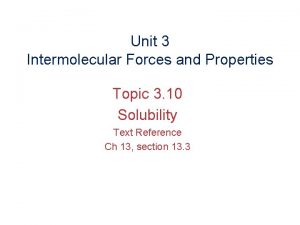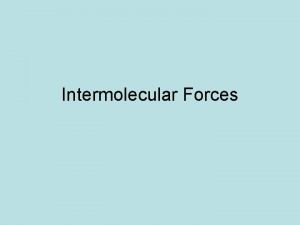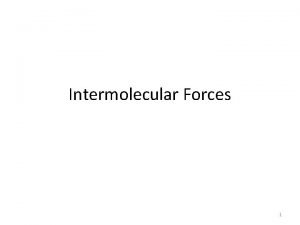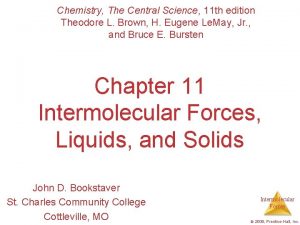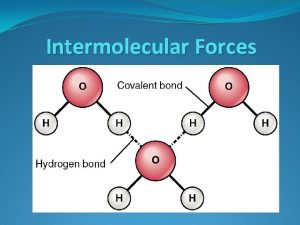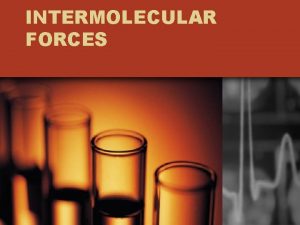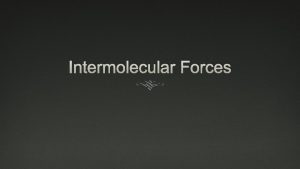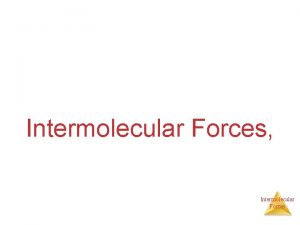Chemistry I Honors Structure and Properties Intermolecular Forces












- Slides: 12

Chemistry I Honors Structure and Properties Intermolecular Forces

What are IMF’s • These are forces of attraction that exist between the representative particles of pure substances. • We typically recognize six different types of these forces. • These IMF’s give pure substances many of their physical properties. • We use a knowledge of the IMF’s to explain why different substances have differences in these characteristics.

1 st – London Force • This is the easiest of the forces. • It is simply an attraction between the particles of all substances. • The strength of this attraction does vary from substance to substance. • Its magnitude depends on the molecular weight of the substance. • Greater the weight greater the London force. • Must note that London force is the weakest of the IMF’s

2 nd – Dipole-Dipole Interaction • Strange name !! • First – all polar molecules are said to possess a “dipole”. • This means that they have two poles (ends that are relatively positive and negatively charged. • We have already seen how a molecule can be polar. – Difference in electronegativity between the atoms that are bonded. – Presence of one or more unbalanced lone pairs of electrons on the central atom.

Polar Molecules

What Happens? • In dipole-dipole interaction, the oppositely charged ends of polar molecules are attracted to each other. • This IMF is stronger than the London force described earlier. • Also, it only applies to polar covalent substances.

3 rd – Hydrogen Bonding • This is a very specialized form of dipole-dipole interaction. • The molecules involved have very specific requirements of their composition. • Hydrogen bonding is stronger than dipole interaction because it is more of a chemical bond than just an attraction force. • The hydrogen bond is a half-strength covalent bond that forms between a Hydrogen atom on one polar molecule and the F, O, or N atom of a 2 nd polar molecule.

Examples and Diagrams

Water and Ammonia

H-Bonding in DNA

4 th – Crystal Lattice Energy • This IMF describes the strength and stability of the crystal structure of an ionic compound. • It is a very strong IMF – much stronger than the partial bond strength of Hydrogen bonding.

Last Two IMF’s • IMF #5 is Metallic Bonding • IMF #6 is Covalent – the same type of Networking. bonding that was • Also described in previous described in the last lesson on Classification of • Generally regarded as the Substances. strongest of the IMF’s. • There is variation in the strength of this IMF, but it is commonly regarded as being as strong as Crystal Lattice Energy.
 Unit 3 intermolecular forces and properties
Unit 3 intermolecular forces and properties Intra vs intermolecular forces
Intra vs intermolecular forces Intra vs intermolecular
Intra vs intermolecular Intramolecular forces vs intermolecular forces
Intramolecular forces vs intermolecular forces Cnof chemistry
Cnof chemistry Kuei honors chemistry
Kuei honors chemistry What is the answer
What is the answer Honors chemistry summer assignment
Honors chemistry summer assignment No3 polarity
No3 polarity Intermolecular forces present in hbr
Intermolecular forces present in hbr Van der waals gecko
Van der waals gecko Intermolecular forces
Intermolecular forces Viscosity and intermolecular forces
Viscosity and intermolecular forces
